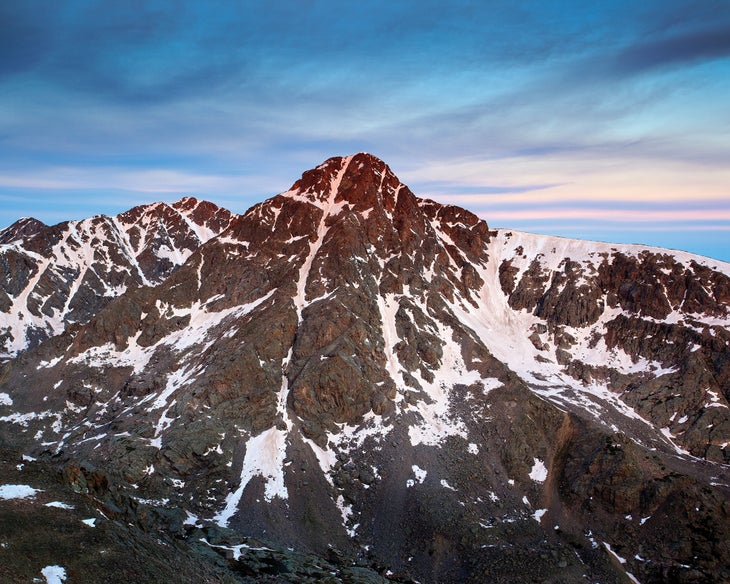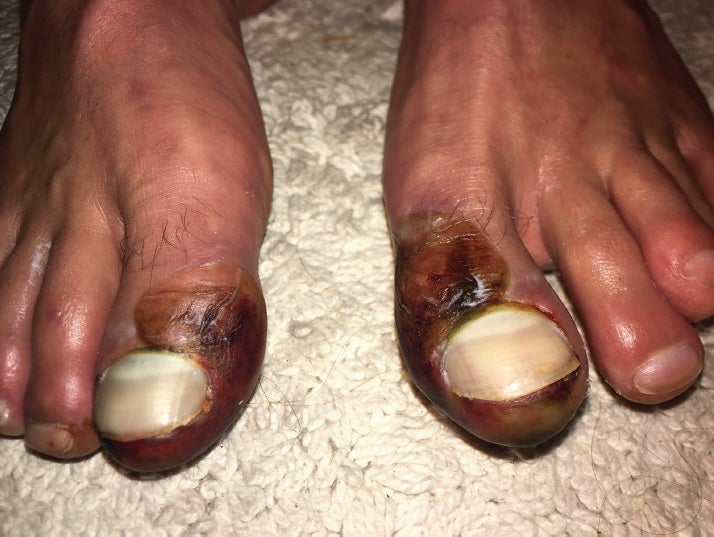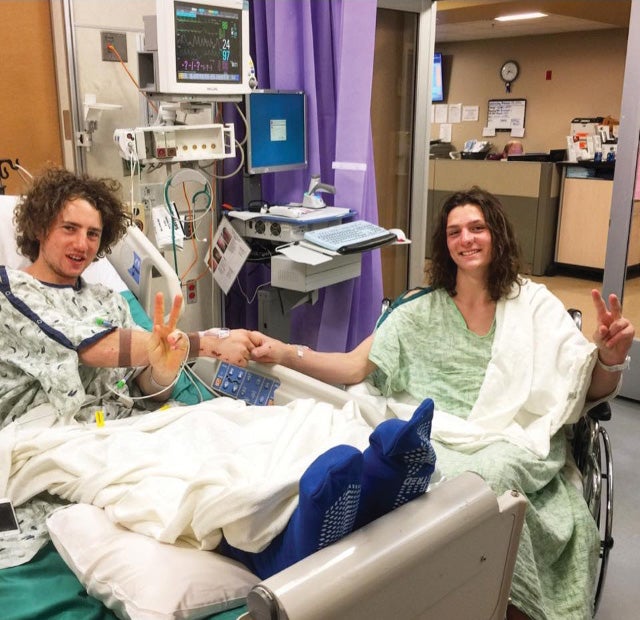Heading out the door? Read this article on the new Outside+ app available now on iOS devices for members! Download the app.
Matt and I were halfway up 1,200-foot Cross Couloir, on Colorado’s 14,009-foot Mt. of the Holy Cross, when the storm rolled in a day early. That’s when we knew we were screwed.
Two days prior, the forecast told a different story. There was a clear weather window within our Colorado Springs high school’s Thanksgiving break—one of our only opportunities to tick off Mt. of the Holy Cross together. We’d already bagged several of Colorado’s Fourteeners in winter, and we’d been eyeing Holy Cross’s steep, snow-filled couloir for a while. The plan was to stash overnight gear at a Patricia Lake basecamp, 3.75 miles from the trailhead. From there we’d go for the couloir with summit packs and climbing gear, then return to hike out that night. We planned to start the two-hour climb in the afternoon, when the snow was soft enough to kick into.
We arrived at the base of the couloir at noon. About 300 feet up, the snow was deeper than we expected, but the sky was clear, we were on schedule, and the climb seemed well within our abilities. Plus, we knew we’d have cell service on top of the peak. We didn’t expect to need it, but we thought of it as a safety net.
We were right about the cell service, but wrong about the two-hour climb. The higher we went, the deeper the snow became. Soon it was loose and unconsolidated all the way to the rock. We were moving more slowly than expected, but if the weather held, we’d still make it up before dark.

A few hours in, laboring upward within the steep couloir walls, we couldn’t see the dark clouds moving in from the west. The first flakes came mid-afternoon. By 5:30 p.m., snow pounded down, the wind drowned out our shouts to each other, and the summit remained impossibly far away.
If there was ever a time to bail, this was it, but behind us, the snow was kicked-out and slick from our climbing—and too unstable to build an anchor or self-arrest in a fall. With rappelling or down-climbing the 40-plus-degree slope out of the question, we went with our only viable option: pushing on toward the summit, and descending the mellow North Ridge as soon as possible.
I tried to focus on remaining calm and moving forward in the growing darkness. The blizzard flashed through our headlamp beams and pelted our faces with ice. When I looked down at Matt, his grave stare mirrored how I felt.
When we finally topped out at 7 p.m., we figured the worst was over. We called our parents and told them everything was fine and that we were going to hike down.
But when we looked around, we saw only sheer drop-offs and total darkness. There was no way to find our descent, which is notoriously easy to miss even in daylight. Plus, the wind up top was blowing at 50 mph, making it dangerous to approach any steep drops. With no choice but to hunker down, we settled under an overhanging lip of rock 200 feet below the summit to wait out the storm. We had what we were wearing—ski jackets, insulated pants, hats, and gloves—plus a little food and water. We hoped it would be enough.
Conditions worsened. Wind whipped through our improvised shelter, and our feet grew painfully cold. We took off our boots and socks and put our feet in each other’s armpits, massaging our white toes to keep the feeling in them.
I couldn’t help thinking about how my parents would react to news that we’d died up there overnight. That’s when the gravity of our situation started to sink in. I’d been feeling pretty cocky up until this point, but now I was truly scared. Not that it mattered—there was nothing I could do but sit there, listen to my own breathing, and tell myself that morning would come.
Temperatures dropped to -20°F with windchill that night. I stopped shivering, a sign of hypothermia, but Matt and I stayed positive, and I’m convinced that was the only thing that got us through the night. I must have drifted off, because the next thing I remember was the sun’s warmth washing over us. Matt rustled awake. I smiled at him and said, “What’s up, dude? We’ve gotta get going.”

The storm had passed, but the descent was still hard to find. We saw several ridges, and at the bottom of one, we spotted what looked like East Cross Creek, which we’d walked along two days before. We rappelled toward it. Home free, we thought.
But when we reached the creek, we realized it was flowing the wrong direction. We’d accidentally gone down the South Ridge—the opposite direction of the trailhead. And now, to compound the problem, we’d dropped out of our only window of cell service. On the summit the night before, we worried about surviving. Now, we were just pissed off, low on food, and tired as hell. Still, we were confident we’d find our way out.
Below treeline, we picked up a trail in the snow and came to a spot we thought we recognized as the east side of the mountain. We weren’t ready to admit that our delirious minds may have been playing tricks on us. We followed faint trails through the forest, turning here and there as the compass dictated, but we always ended up back where we started. We later found out locals call the area the Bermuda Triangle: Iron in the rocks can throw off magnetic instruments, and our compass was taking us in circles.
We knew we should have stayed put to wait for rescue, but we couldn’t: With creek-soaked boots, it was either move or freeze.
Our optimism was waning. I’d start to feel a frog in my throat, but in those moments, you have to either crack a joke or cry, so we messed around, talked about girls, sang classic rock songs, and laughed about whatever we could. Any distraction to keep us moving.
As the sun went down on our second unplanned night out, we gathered tinder and took out our lighters. Click. Click. Nothing. They remained waterlogged with snowmelt, despite our efforts to dry them. I swallowed the frog in my throat.
By this point, Matt was too weak to continue, so I piled pine branches on the snow for us to spoon on top of. We managed to laugh at a few cuddle jokes, but we were starting to realize that our families didn’t know if we were alive. That made it tough to keep things light.
Soon we both stopped shivering, and neither of us could feel our feet. Matt turned to me. “Tommy, we could die out here,” he said. “I’m OK with it because I’m still glad to not be on the couch playing video games, but this is much earlier than I thought it would be. I’m not ready.” We laid in silence.
Matt fell asleep with his head on his right hand, a position that would cut off circulation just enough to give him frostbite in his thumb.
Again, temperatures dropped below freezing, and again we woke up in the morning, somehow still alive. We hadn’t been hiking long when we saw a helicopter. It was distant, but for us, it took up the whole sky.

Numb feet forgotten, we ran into a meadow, and I waved a jacket and a trekking pole with a bright red hat on it. The chopper flew right past us. It circled back four more times before flying off. We felt like we’d watched our last chance vanish. That’s when we finally broke down.
There was nothing to say. Matt just laid his head on my lap, and we both sobbed.
An hour later, the helicopter returned (it had only turned back to refuel), and this time, it came straight to us. We couldn’t stop smiling. It was finally over. I was so elated I tried to hug a rescuer, who just threw me onto a jumpseat and strapped me in. “We were told to look for bodies,” he said.
As soon as we flew off, I could feel the adrenaline drain out of me. My whole body was in pain I’d been too numb to feel until now. But still, I’d never felt better.
Key Skills
Survive an Unplanned Winter Overnight
Find shelter: Get out of the wind. No rocks or trees? Dig a trench in the snow and lie down inside. Use branches to insulate yourself from the ground.
Boost warmth: Huddle with a partner, or build a fire (light pine resin or peel bark off deadfall to find dry wood).
Keep moving: Exercise to stay warm if you must (but don’t get sweaty).
Prevent frostbite: Loosen tight boots and keep toes and fingers wiggling. Tuck cold digits into your — or your partner’s — armpits, neck or groin. Numb, waxy, or mottled skin? Wait for a doctor to rewarm.
–Corey Buhay